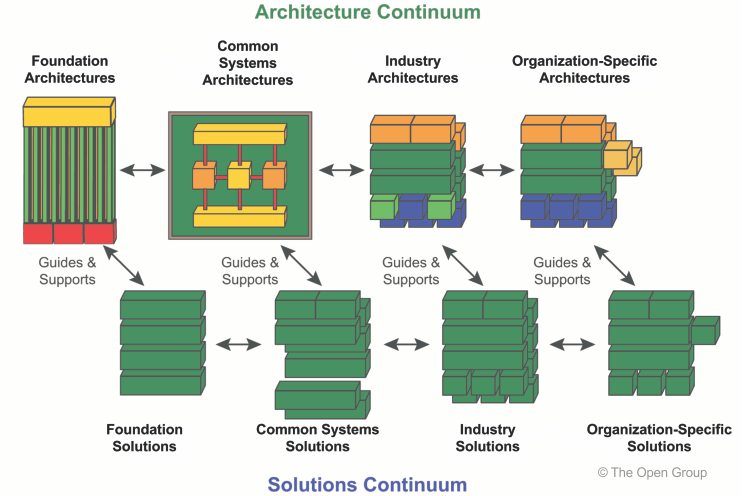Introduction
In the dynamic realm of enterprise architecture, TOGAF introduces two essential concepts that act as guiding frameworks— the Architecture Continuum and the Solutions Continuum. These continuums provide a structured approach to the development and implementation of architectural assets, offering a roadmap for organizations seeking clarity and efficiency in their IT landscape. In this exploration, we delve into the nuances of these continuums, uncovering how they shape abstract concepts into concrete, organization-specific assets.

The Architecture Continuum is like a roadmap that guides the development and evolution of architectural assets. It provides a systematic way to define and understand the rules, representations, and relationships within an architecture. It’s essentially a structured way of looking at Architecture Building Blocks (ABBs), which are reusable assets in an architecture.
As ABBs evolve through their lifecycle, they move from being abstract and generic entities to fully expressed, organization-specific architecture assets. This continuum helps establish traceability and derivation relationships, indicating, for instance, that an Organization-Specific Architecture is built upon an industry or generic standard. The Architecture Continuum also reveals the relationships among foundational frameworks (like TOGAF), common system architectures, industry architectures, and enterprise architectures. It’s a powerful tool for discovering commonalities and reducing redundancy in the architectural landscape.
Now, moving on to the Solutions Continuum. This is the implementation phase. It provides a consistent way to describe and understand the realization of assets defined in the Architecture Continuum. In simpler terms, it deals with Solution Building Blocks (SBBs) that are reusable components within an organizational environment.
These solutions emerge from agreements between customers and business partners and essentially bring to life the rules and relationships laid out in the architecture space. The Solutions Continuum is where you see the actual products, systems, and services that result from the implementation of architectural assets. It helps address both commonalities and differences among these implemented systems.
In a nutshell, the Architecture Continuum sets the stage, defining the rules and relationships, while the Solutions Continuum takes those definitions and turns them into tangible, implemented assets within the organizational environment. Together, they provide a structured approach to managing the complexities of enterprise architecture.
Examples of TOGAF’s Continuum
Let’s dive into some examples to illustrate the concepts of the Architecture Continuum and the Solutions Continuum in TOGAF.
Example of Architecture Continuum:
Let’s say a large organization is adopting TOGAF to streamline its IT architecture. They start with foundational frameworks, perhaps using TOGAF itself as a reference. As they move along the Architecture Continuum, they define abstract and generic entities called Architecture Building Blocks (ABBs).
For instance, they might identify a Security ABB at an abstract level. Over time, this abstract Security ABB evolves, gaining specificity and becoming an Organization-Specific Architecture asset. This could include detailed security policies, procedures, and technologies tailored to the organization’s needs. The Architecture Continuum, in this case, captures the journey from the initial abstract concept to a fully articulated, organization-specific asset.
Example of Solutions Continuum:
Now, let’s look at the Solutions Continuum. Building on the Security example from the Architecture Continuum, the organization moves to the implementation phase. In the Solutions Continuum, they define concrete, reusable Solution Building Blocks (SBBs) that align with the evolved Security ABB.
This might involve selecting specific security technologies, such as firewalls, intrusion detection systems, and encryption methods. The agreements with vendors and the deployment of these technologies represent the realization of the rules and relationships defined in the architecture space. The Solutions Continuum, therefore, showcases the actual products, systems, and services that result from the implementation of the Security ABB.
The Architecture Continuum traces the evolution of abstract concepts into specific, organization-specific assets, while the Solutions Continuum focuses on the practical implementation of those assets, detailing the tangible components and systems that bring the architecture to life.
Summary
TOGAF’s Architecture Continuum serves as the blueprint for architects, mapping the journey of abstract entities, known as Architecture Building Blocks (ABBs), as they evolve into fully expressed, organization-specific assets. This continuum fosters traceability and derivation relationships, streamlining the architectural landscape by discovering commonalities and eliminating redundancy.
Complementing this is the Solutions Continuum, the realm where the architectural vision materializes. Here, tangible Solution Building Blocks (SBBs) emerge as the products, systems, and services resulting from agreements between stakeholders. It addresses both commonalities and differences among implemented systems, offering a comprehensive view of the realized architecture.
Together, these continuums provide a holistic approach to architecting, guiding organizations through the intricate process of conceptualization, evolution, and implementation in the ever-evolving landscape of enterprise architecture.